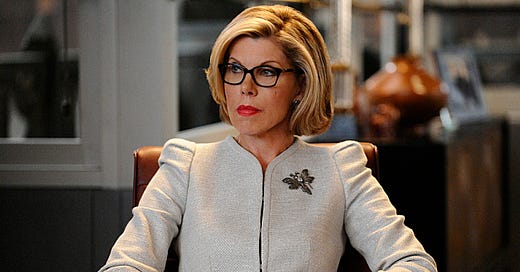Law & Disorder
The Good Fight (2017-2022) is a show obsessed with the first Trump term. It feels like comfort food during the second.
I don't know if doctors and police officers enjoy watching TV shows about their jobs. Maybe they spend their nights rolling their eyes at Grey's Anatomy and 911. But I’ll admit it: I love a good lawyer show. Two of my favorites are The Good Wife (2009 to 2016) and its wild and prophetic spin-off, The Good Fight (2017 to 2022).
Where The Good Wife had its roots in high-gloss scandal, cases ripped from recent enough headlines and clever legal drama, The Good Fight becomes its own savage beast over the course of six seasons. When the show launched, it originally had Diane Lockhart, the ever-composed liberal lioness, poised to retire in peace. But then Trump won. Literally. The show scrapped its original pilot and rewrote the first few minutes so we could all join Diane as she stared blankly at her TV while Trump was sworn in. She decides to retire to a chateau in France, except she then learns her retirement fund vanished in a Ponzi scheme, and her plans for a graceful exit were replaced with a reluctant, angry re-entry into the legal grind.
The decision to toss the script and start with a gut punch set the tone for what would become one of the most politically raw shows on television. While other legal dramas worked in a fictional vacuum, The Good Fight was reading the New York Times and Politico right alongside the rest of us in real time. It didn't just acknowledge the Trump presidency. It made the administration a crucial part of the show’s identity, looming large over the characters (and us) as we tried to get on with our lives.
The plots weren’t subtle. There were Russian pee tapes, Michael Cohen cameos, alt-right judges, and the infamous Memo 618, a mysterious document suggesting some people were legally untouchable. In particular, season four’s Memo 618 plotline fascinated and rankled me as an attorney who believes in the rule of law. There were also musical explainers about NDAs and fascism, even one involving Google and China which CBS forced the show’s creators to remove. At times it felt like the writers room had mainlined Twitter. And yet, it worked. All six seasons of the show rank 91% or higher on Rotten Tomatoes, and Variety places it in their 100 Greatest Shows of All Time.
Watching it in real time during Trump’s first term felt like a fever dream – so much so that I finished the first season in 2017 and didn’t watch the show again until 2025. I had enough DJT in the real world, why did I want to invite his specter into my downtime? The show refused to offer the usual TV comfort of resolution. Cases were lost. The rules were bent. Even Diane—our polished, pearls-and-pinot liberal hero—got sucked into a secret resistance group and started microdosing to cope with the existential dread. Honestly, relatable.
Then Trump lost the 2020 election. The collective exhale came quickly. It felt like maybe we were moving on. The Good Fight wasn’t so sure. Even after he left office, the show kept sounding the alarm. His presence loomed in the storylines like a stain that wouldn’t come out. This chaos had changed the world, and the show’s writers following much of that chaos through logical conclusions, including an episode about January 6th.
I can’t really explain it, but watching this show – very much so about Trump’s first presidency – is oddly comforting. Maybe it’s because it felt like there was so much more to make fun of during the first term. But now, in the early days of a second Trump term moving to effectuate its policies with lightning speed, revisiting these plot points from the first term feels almost benign.
What once felt too loud or too anxious now feels almost soothing. Pee tapes? Sure. Cohen being shady? Familiar. Diane trying to fight the slow death of the rule of law while looking like a million fucking dollars? Honestly, that’s comfort TV now. In a world where institutions feel even shakier than they did the first time around, there’s something oddly therapeutic about watching characters who never believed everything would be fine in the first place. And over six seasons, the show evolved into something almost unclassifiable: part legal procedural, part satire, part fever dream, and part resistance art. Where else are you going to get episode titles like “The Gang Discovers Who Killed Jeffrey Epstein?”
The Good Fight didn't age into a relic of the Trump era. It aged into a warning label. It was a show that shouted “this is not normal” long before anyone else stopped pretending it was. And revisiting it now feels like reconnecting with that one friend who saw the train wreck coming and tried to tell you it wasn’t just a weird detour.
Diane Lockhart never got her peaceful retirement. She got fake judges, shadowy conspiracies, and an endless string of moral compromises. And somehow she still put on her blazer and showed up for court. That’s the kind of hero I need in this sequel timeline we’re all stuck in.

So no, I don’t think I’d recommend The Good Fight to just anyone looking for a distraction. But if you're a lawyer, a political junkie, or just someone quietly screaming into your morning coffee these days, go ahead and check it out. It might make you laugh. It might make you mad. But at the very least, it’ll remind you that you’re not crazy. Things really were (and still are) that messed up.
And for what it’s worth, Diane never gave up. So maybe we shouldn’t either.




